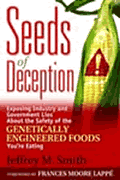Related
Articles:
Cal. County Bans Genetically Modefied Seeds (GMO's)
Hungarians
Protest Agains
GMO Grain
Other
Smith
Articles:
How to Avoid Genetically
Modefied Foods
GENETICALLY
MODIFIED PEAS CAUSED DANGEROUS IMMUNE RESPONSE
PART 2 of 2
By
Jeffrey Smith
January 14, 2006
NewsWithViews.com
Approvals Rely on Dangerous Assumptions
Industry�s assumption that proteins will act in a predictable manner in a new organism has been pivotal and it certainly helped them get GM foods approved. Take, for example, their acute toxicity tests where they feed rodents just the isolated protein.
They don�t necessarily extract the protein from the GM crop. Instead, they almost always produce the protein using genetically engineered bacteria, since it is cheaper and easier. They then test the animals� reactions to this surrogate protein, assuming that if animals don�t react to the bacterial form, then they�and humans�won�t react to the plant form.
These tests, therefore, avoid measuring the health impact of any changes in the protein in the GM crops we actually consume. The pea study revealed that significant, potentially deadly changes occurred when the gene from kidney beans is inserted into peas�closely related species. But the genes put into GM foods already on the market cross entire kingdoms. Bacterial genes are spliced into GM soybeans, corn, cotton and canola, and viral genes are inserted into papaya, zucchini and crook neck squash. How these crops will alter bacterial proteins is anyone�s guess�unfortunately.
Glycosylation is related to another possible problem. Proteins are sometimes folded in precise formations by specialized �chaperone� folders inside the cell. If a novel protein appears in a species where it has never before existed, the chaperone folders might not do their jobs right. A mis-folded protein can be quite dangerous. In the case of the peas, the difference in glycosylation means that the protein is almost certainly a different shape, but there may be other shape-related issues that contributed to the immune reaction in mice.
In addition to changes in the target protein, side-effects from the gene insertion process can create toxins, allergens, or adjuvants. Earlier unpublished tests on the GM peas, for example, showed a doubling of trypsin inhibitor, a known allergen, and a fourfold increase in an anti-nutrient called a lectin. These or some other unknown change in the peas� composition might have played a part in increasing the immune responsiveness of the mice. In short, we don�t really know why genetically engineered peas are more dangerous. We do know that the body interprets something in the pea as foreign, different, and offensive, and it reacts accordingly. On the other hand, all GM foods, by definition, have something foreign and different. It makes sense that the immune systems in humans or animals that have never eaten these novel substances before may react to them.
A handful of studies that have looked for immune responses have found them. In 1995, a Brazil nut gene inserted into soy DNA created an allergic reaction in human blood, and the project was stopped.[1] In 1998, a GM potato caused immune system damage in rats, among other problems.[2] Studies implicating the Bt-toxin have already been cited above. On top of those, a Bt potato caused abnormal and excessive cell growth in the small intestine of mice.[3] A feeding study with Bt corn called MON 863 caused a significant increase in male rats of three types of blood cells: basophils, lymphocytes (22%) and total white cell counts (20%).[4] This strongly suggests that consuming GM corn caused changes in the immune system. According to GM safety research expert Arpad Pusztai, �A consistent feature of all the studies done, published or unpublished, including MON 863, indicates major problems with changes in the immune status of animals fed on various GM crops/foods, the latest example of this coming from the GM pea research in Australia.�[5]
We don�t have the advantage of sophisticated human clinical trials, so our evidence for immune reactions in humans is limited and preliminary. For example,
-
Soy allergies jumped 50% in the UK just after GM soy was introduced;[6]
-
An expert panel in the US determined that there was a moderate likelihood that StarLink Bt corn contained a human allergen;[7]
-
Filipinos living next to Bt cornfields developed severe symptoms three years in a row�only while the corn was pollinating;[8] and
-
A recent health report claims that Indian farm workers exposed to Bt cotton developed moderate or severe allergic reactions.[9]
Certainly allergies and asthma are on the rise in many nations, but at this point, we can only guess whether GM food plays a part. The pea study provides a clue how it might be related.
Spin
No report on GM research is complete without the fourth pillar�spin. How do you suppose the industry will respond to these pea findings that expose an inept regulatory process that under normal test procedures would almost certainly have allowed these peas onto the market? Consider the response of GM pea developer TJ Higgins, �I think that this shows that the regulatory system works.�[10]
But before we condemn Higgins as a spin master, we must consider that he might have been the victim of spin himself. I have spoken with many biotech scientists, people of high integrity and a strong belief in what they are doing, who have absolutely no idea about the wretched state of regulations or safety assessments. They focus on their own area of expertise and have bought the industry spin about safety.
I called Higgins in Australia and quizzed him on the state of affairs of regulations and assessments of other GM foods. He said, �I didn�t feel that we were breaking particularly new ground. . . . We were following basically the recommendations for a proper risk assessment and I feel it is typical of the kinds of assessments that have been done for other GM crops around the world.� Lead researcher Simon Hogan told me the same thing. I pointed out to both scientists several unique features of their study and challenged them to name a single GM food on the market that has had the same level of tests. They couldn�t come up with any, but they were sure that these tests were done.
They�re in for a shock.
Years ago, a pro-GM scientist with high integrity also had confidence in GM regulators and industry scientists. Higgins had asked him to coauthor a rat feeding study with his GM peas, because the scientist was the world�s most qualified person to do the work. This scientist was also awarded a UK government research grant to create a rigorous safety assessment protocol, which was to be required in the UK and eventually the EU. One day, he was asked to review several confidential industry studies that were used to get GM foods approved. He told me that reading those studies was perhaps the greatest shock of his life. The studies were so superficial, so poorly done, he realized that industry was doing as little as possible to get their foods on the market as quickly as possible. They were not doing safety studies. A few weeks later, this scientist confirmed that a GM potato he was working on caused considerable damage in rats, including damage to their immune systems. Unlike Higgins, this man knew full well that his dangerous potatoes could have sailed through industry �safety� studies and onto plates around the world. He went public with his concerns.
The scientist�s name is Arpad Pusztai, and he paid dearly for his integrity. At the hands of a pro-GM government and industry-backed scientists, he was fired, silenced with threats of a lawsuit and mercilessly attacked. It was biotech spin at its �finest.�
Pusztai has since published his potato research and is now considered a top expert in GM safety testing. He just published a review of all the peer-reviewed assessments and has studied nearly every industry submission. He assured me that the GM pea immune study does, in fact, break new ground. Likewise, Professor G.E. Seralini, who has officially reviewed all of the submissions to Europe as well as all the commentaries on the submissions, wrote me: �To my knowledge, no GM plant on the market has undergone such detailed experiments to assess allergenicity.� Doug Gurian-Sherman and Bill Freese, who are experts on submissions to US authorities, also acknowledge that industry immune studies are considerably weaker than the pea study. And Judy Carman, who has studied the GM applications to Australia and New Zealand, concurs. In fact, Marc Rothenberg, who is a co-author of the pea study and was also on the expert panel that analyzed the allergenicity of StarLink corn, said of the pea research, �It was very unique. It was much more extensive and rigorous than what was previously done.�
It appears that the director of the pea assessment (Higgins) and the lead researcher in the study (Hogan) were uninformed about the state of affairs in GM crop assessments.
They appeared to be unaware that their study was actually a breakthrough. If Higgins had known that his peas would likely have been approved if they were tested only with the less expensive, less rigorous research typically used for GM crops, he might not be so quick to defend GM regulations worldwide.
I sent Higgins a peer-reviewed paper called �Safety Testing and Regulation of Genetically Engineered Foods.�[11] It not only shreds the assessment process in the US, it also presents a case study of how one GM corn variety gained approval based on wrong assumptions, poor research, ineffective regulations and spin�the four pillars. I wrote Higgins, �I am confident that after reading this article, you will agree with the authors that the tests used for approving thisBt corn, as well as other varieties, were not sufficient to protect the public.� I asked that he then make corrective statements about GM regulations. More importantly, Higgins is The Deputy Chief of CSIRO Plant Industry.
|
Subscribe to the NewsWithViews Daily News Alerts! |
If he acknowledges that even one GM crop has not been thoroughly tested, I asked him to propose that his organization immediately conduct rigorous safety assessments on that crop to protect the health of consumers. I understand that CSIRO has business relationships with Bayer Crop Science and Monsanto. The close ties between research organizations and the biotech industry has, in many instances, stifled criticism of GM crops and even stopped important research from being conducted. I am hopeful that Higgins, who pioneered new safety assessments on GM food crops and canceled his own 10 year pea project based on the findings, will direct his institution to similarly break new ground. I will be sure to report his response in future columns.
In the meantime, my Institute for Responsible Technology is passing the hat to collect money to fund independent research on the GM foods already on the market. We are not willing to wait.
Click here for part -----> 1
The letter to TJ Higgins can be found by clicking here.
Spilling the Beans is a monthly column available at responsibletechnology.org. Publishers and webmasters may offer this article or monthly series to your readers at no charge, by emailing column@responsibletechnology.org. Individuals may read the column each month by subscribing to a free newsletter at responsibletechnology.org.
Footnotes:
1,
J Ordlee, et al, "Identification of a Brazil-Nut Allergen in Transgenic
Soybeans," The New Englandd Journal of Medicine, March 14, 1996
2,
Pusztai, A. et al. (2003) Genetically Modified Foods: Potential Human
Health Effects. In: Food Safety: Contaminants and Toxins (ed. JPF
D'Mello) pp.347-372. CAB International, Wallingford Oxon, UK, also
additional communication with Arpad Pusztai
3,
Nagui H. Fares, Adel K. El-Sayed, Fine Structural Changes in the Ileum
of Mice Fed on -Endotoxin- Treated Potatoes and Transgenic Potatoes,
Natural Toxins Volume 6, Issue 6, 1998. Pages: 219-233 Published Online:
29 Jun 1999
4,
The
Study Report, pdf file
5,
October 24, 2005 correspondence between Arpad Pusztai and Brian John
6,
Mark Townsend, "Why soya is a hidden destroyer," Daily Express, March
12, 1999
7,
SAP Report No. 2000-06, December 1, 2000, FIFRA Scientific Advisory
Panel Meeting, November 28, 2000, Assessment of Scientific Information
Concerning StarLink� Corn
8,
Jeffrey M. Smith, Bt-maize (corn) during
pollination, may trigger disease in people living near the cornfield,
Press Release February 2004, and Allen V. Estabillo, Farmer's group
urges ban on planting Bt corn; says
it could be cause of illnesses, Mindanews / 19 October 2004
9,
Bt
cotton causing allergic reaction in MP; cattle dead, Bhopal, Nov
23 2005
10,
GM
crop failure shows rules force: CSIRO November 19, 2005,
11,
William Freese and David Schubert, Safety
Testing and Regulation of Genetically Engineered Foods, Biotechnology
and Genetic Engineering Reviews - Vol. 21, November 2004
� 2006 Jeffrey M. Smith- All Rights Reserved
Sign Up For Free E-Mail Alerts
E-Mails are used strictly for NWVs alerts, not for sale
Jeffrey M. Smith is working with a team of international scientists to catalog all known health risks of GM foods. He is the author of Seeds of Deception, the world's bestselling book on GM food, and the producer of the video, Hidden Dangers in Kids' Meals.
Website: www.seedsofdeception.com
E:Mail: info@seedsofdeception.com
The pea study revealed that significant, potentially deadly changes occurred when the gene from kidney beans is inserted into peas�closely related species. But the genes put into GM foods already on the market cross entire kingdoms.









